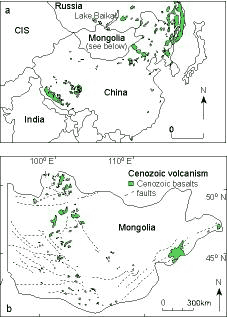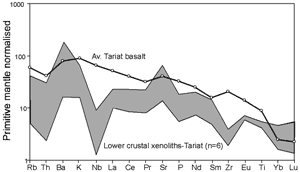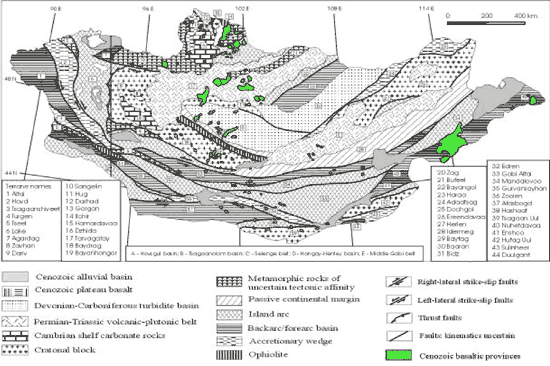 |
Diffuse,
long-lived Cenozoic volcanism in Mongolia; thermally
anomalous upper mantle? |
T.
L. Barry1,
A.
D. Saunders2
& P. D. Kempton3
1School of Geography, Geology and the Environment, University of Leicester, University Road, Leicester LE1 7RH, UK, tlb2@le.ac.uk
2Geology
Dept, University of Leicester. LE7 1RH, UK, ads@leicester.ac.uk
3NIGL,
Keyworth, NG12 5GG and currently at NERC, Polaris
House, Swindon, SN2 1EU, UK, P.Kempton@nigl.nerc.ac.uk
 Click here to
download a PDF version of this webpage Click here to
download a PDF version of this webpage
|

Figure 1. (a) Regional distribution of Cenozoic
volcanism throughout Russia and China (based
on data from Whitford-Stark, 1987, Fan &
Hooper, 1989 and Lysak, 1995). (b) Distribution
of Cenozoic volcanism throughout Mongolia (from
Barry
et al., 2003).

Figure 2. Primitive mantle-normalized trace-element
distribution pattern for an average basalt composition
from central Mongolia (Tariat volcanic province),
and the compositional range of crustal xenoliths
from the same location. Note the large difference
between the basalt and xenolith compositions
for Nb, La, P, Zr and Ti.

Figure 3. Plot of 143Nd/144Nd
versus 87Sr/86Sr for Mongolian,
Chinese and Siberian basalst and xenoliths (from
Barry
et al., 2003; data sources within).
|
Diffuse, small-volume basaltic
volcanism has occurred intermittently throughout
central Mongolia for the past 30 My. The causes
of long-lived intraplate volcanism can be difficult
to understand not least because of factors such
as timing of regional and/or localised extension,
timing of uplift, presence of possible crustal
weaknesses and the timing of the magmatism itself.
The problem is most acute in central and east
Asia, one of the largest and least known areas
of intraplate igneous activity (Barry &
Kent, 1998; Barry
et al.,
2003). In this region, Cenozoic basalt fields
are scattered across an area approximately 2000
km from east to west, and 1500 km from north
to south (Whitford-Stark, 1987) covering
southern Siberia, central Mongolia and NE China
(Figure 1).
Mongolia provides an excellent opportunity
to study intraplate continental volcanism
that is far removed from subduction zones
and continental rifts. The crust within central
Mongolia is estimated to be 45 km thick on
the basis of P-T studies of crustal xenoliths
(Stosch et al., 1995). Despite
having erupted through 45-km-thick crust,
the basalts appear to show little crustal
contamination (Figure 2; Barry
et
al., 2003).
Mongolian volcanic provinces provide an important
link between Cenozoic basalt volcanics to
the north around the Baikal rift zone, in
Russia (see also One
rift, two models), and similar aged basalt
volcanic provinces to the east in NE China
spatially associated with extensional grabens.
Volcanism and rifting in the Baikal region
have been explained by several suggested processes
including (1) partial melting of upper mantle
due to either small asthenospheric diapirs
(Ionov et al., 1998) or a large
mantle plume (e.g., Logatchev , 1984;
Windley & Allen, 1993), (2) a crustal
weakness (Yarmolyuk et al.,
1991), and (3) the combined effects of the
India-Asia collision with secondary input
from a mantle plume (Khain, 1990).
Within NE China, Cenozoic volcanism has been
attributed to passive upwelling of ocean island
basalt (OIB) and/or mid-ocean ridge basalt
(MORB) type mantle, with subsequent modification
of magmas by assimilation of continental lithospheric
mantle or crust (e.g., Song et al.,
1990; Tatsumoto et al., 1992).
A close spatial relationship between older
Paleogene Chinese basalts and sedimentary
basins suggests that, initially at least,
Cenozoic magmatism was associated with extension
and thinning of the lithosphere along the
eastern margin of the Eurasian plate (Northrup
et al., 1995). This in turn was related
to the rate of convergence between the Pacific
plate and Eurasia, with the Indo-Eurasian
collision only a “far-field” influence
(cf . Northrup et al.,
1995). Younger Neogene basalts, however, are
not confined to basins.
|
Despite the contrasting explanations
for the volcanism in Russia and China, the chemical
composition of lavas in Baikal, Mongolia, and NE China
are remarkably similar, especially given the large variation
in underlying crustal and lithospheric mantle compositions
and the wide range in eruption ages, i.e.,
sporadically throughout the past 30 Myr (Figures 3 &
4; Barry & Kent, 1998). And yet Mongolia
shows neither rifting-dominated processes such as are
evident along the Baikal rift zone, extension-related
processes nor changes in subduction convergence such
as in the NE China basins. The independence of the basalt
volcanism from crustal composition and structure suggests
that the mantle source region beneath this vast area
has played a significant role in contributing to magma
genesis. Therefore, when considering a model to explain
Mongolian volcanism, it seems reasonable to seek a single
general model that can explain the volcanism throughout
all these regions.

Figure 4. Terrane (compiled by Badarch
et al., 2002) and volcanic provinces (compiled by Barry
et al., 2003). (Modified from Whitford-Stark, 1987).
Mongolian
basalts do not have the same isotopic composition as
sampled mantle xenoliths, suggesting that the basalts
are not derived from a source represented by the xenoliths.
Trace element, REE and isotopic modeling of Mongolian
basalt compositions indicate that the parental basalt
melts were most likely derived from the lowermost lithospheric/uppermost
asthenospheric mantle. Large-ion lithophile elements
and Nb concentrations suggest derivation from recently
metasomatised lithosphere [see also Metasomatic
OIB]. This is further supported by studies of mantle
xenoliths erupted in the Mongolian and Russian basalts
that show multi-enrichment and replacement textures
(Ionov, 1994). There is no evidence for high
heat flow within the mantle beneath Mongolia (Khutorskoy
& Yarmolyuk, 1989) as one might expect if a
mantle plume were present. Instead, recent geophysical
studies infer anomalously dense material at the base
of the lithospheric mantle (Petit et al.,
2001). The geochemistry of the basalts is therefore
best explained by progressive enrichment of the lithospheric
mantle by small degree partial melts from the asthenosphere.
Even helium isotopes plot within the range of values
found for sub-continental upper mantle and are not elevated
towards high 3He/4He which may
indicate a greater proportion of primordial 3He
(Barry et al., in prep.) [see also Helium:
Fundamental models].
Whilst localized extensional tectonics may have facilitated
transport of magma to the surface, the small amount
of extension within Mongolia is insufficient to account
for the generation of the basalts (cf. McKenzie
& Bickle, 1988), thus suggesting that a mantle
process must initiate melt generation. This raises
the interesting question of how intraplate volcanism
over such a vast area can be sustained, albeit intermittently,
for tens of millions of years, if not by the presence
of a large, long-lived mantle plume? Yet the area
lacks evidence for a high-heat-flux mantle plume and
there is no evidence for age progression of volcanic
eruptions, nor for excess lithospheric temperatures
from mantle xenoliths (Ionov et al.,
1998). Furthermore, there is no geophysical evidence
for a mantle upwelling although the possibility of
small diapiric upwellings, such as imaged beneath
Europe (Hoernle et al., 1995), and perhaps
not resolvable by present tomography, cannot be ruled
out.
Although the plume hypothesis may be inadequate to
explain volcanism in central Asia with the data available
at present, alternative models also struggle. Plate-edge
convection models (cf. King & Anderson, 1998; see also Understanding
the Edge-Driven Convection Hypothesis) fail to
explain the distribution of basaltic provinces within
Mongolia, which appear to be random and with no preferred
occurrence along terrane boundaries (Figure 4). They
also fail to explain why there is no volcanism within
the Baikal rift where a plate-edge convection model
would most likely predict magmatism. Furthermore,
a crack propagation theory seems unlikely given the
45-km-thick crust and again, the non-aligned, broad
spatial and temporal distribution of the volcanic
rocks.
These types of volcanic occurrences present a problem
for the geological community. Without detailed tomography,
we do not know the structure of the mantle beneath
Mongolia, but from the work that has been done, only
the mantle above 200 km appears to have relatively
low velocities (Villaseñor et al., 2001).
However, the geochemical evidence points towards a
process involving asthenospheric fluids and/or melts
infiltrating the lowermost lithosphere. These fluids/melts
must be produced and driven by a process, but what,
and how? A high-heat-flux mantle plume that causes
melting of anhydrous asthenosphere does not appear
to fit the evidence available for central Asia. However,
melting of previously enriched, hydrous lower lithosphere
could be triggered by a low-heat-flux thermal anomaly,
either fed laterally from mantle upwelling elsewhere,
or alternatively caused by thermal blanketing by the
large Asian landmass. The ultimate cause of such a
phenomenon remains enigmatic but, if understood, might
help explain other regions of diffuse, long-lived
intraplate volcanism.
References
- Barry & Kent, 1998, AGU Mono, Geodynamics
Series , 27 , 347-364. (To order book,
visit http://www.agu.org/cgi-bin/agubookstore?topic=SE)
- Barry
et al., 2003, J. Pet , 4 , 55-91.
- Badarch, G. et al., 2002, J. Asian Earth Sciences
, 21 , p.87-110.
- Ionov et al., 1994, J. Pet. , 35
, 753-785.
- Ionov et al., 1998, AGU Mono, Geodynamics Series
, 27 , 127-153.
- Khain, 1990, J. Geodynamics , 11
, 389-394.
- Khutorskoy & Yarmolyuk, 1989, Tectonophysics
, 164 , 315-322.
- King & Anderson, 1998, EPSL , 160
, 289-296.
- Logatchev, 1984, Episodes , 7 , 38-43.
- McKenzie & Bickle 1988, J. Pet. , 29
, 625-679.
- Northrup et al., 1995, Geology , 23
, 719-722.
- Petit et al., 2002, EPSL , 197 ,
133-149.
- Song et al., 1990, Chem. Geol. , 88
, 35-52.
- Stosch et al., 1995, Lithos , 36
, 227-242.
- Tatsumoto et al., 1992, EPSL , 113
, 107-128.
- Villaseñor et al., 2001, Phys.
Earth Plan. Int. , 123 , 169-184.
- Whitford-Stark, 1987, GSA, Sp. Paper. ,
213 , 74 pp.
- Windley & Allen, 1993, Geology , 21
, 295-298.
- Yarmolyuk et al., 1991, Geotectonics , 25
, 53-63.
last updated 5th February, 2005 |
